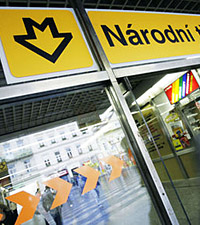
The conservationists do not like the proposal for an elevator to the Národní třída station
 |
The above-ground part of the lift will take the form of a glass cube measuring 5.3 meters by 3.8 meters and a maximum height of four meters. According to the zoning decision, the exit should be at least two meters away from the Church of the Holy Trinity.
"The new construction of the annex is in complete fundamental conflict with all modern and historical views on the insertion of new constructions in the Prague Monument Reserve," asserts the National Heritage Institute in a statement available to ČTK. According to conservationists, the church designed by Jan Jiří Aichbauer and Kryštof Dientzenhofer dominates the entire block, and the annex would devalue the overall view of this monument and the adjacent buildings.
Therefore, the conservationists propose shifting the exit further north of the church to the parking area in front of the Faculty of Education of Charles University or across the street to the end of the dead-end street Omladinářů, as was allegedly suggested earlier. Conservationists are also concerned that the project includes the felling of a mature tree on the site.
The project also proposed ensuring access to Spálená Street, but this would require the demolition of a cubist grille and column. However, the conservationists rejected this. According to Kněžínka, the access to the lift will ultimately be only from Lazarská Street.
"For a long time, a solution has been sought. This is controversial from the perspective of heritage care, and the idealistic view of the conservationists would be to prohibit it. It is a conflict between public interests and heritage care," said Kněžínka to ČTK. He mentioned that the most suitable architectural solution is currently being sought. This will likely form part of the documentation for the building permit.
According to the text of the zoning decision, the lift for the Národní třída station will consist of two shafts, each for two lift cabins. The first shaft will transport wheelchair users or mothers with strollers to a corridor that leads to the station's vestibule. There, they will have to transfer to another lift that connects the vestibule with the station platform. The first shaft will be 30.4 meters deep, while the second will be 11.6 meters.
Initially, several options for the lift's exit were considered, but all other proposals met with opposition from the owners of the affected buildings. According to earlier estimates, the lift could be completed by autumn 2010. However, the construction will be preceded by archaeological surveys. The cost of the lift is expected to be around 170 million crowns and will likely be covered by the transit company.
The construction of the lift will be part of the overall reconstruction of the Národní třída metro station, during which trains will only pass through for about ten months. People opposed the station's closure through a petition signed by several thousand individuals. They called for the construction of a second entrance, which would mean the station would not have to be closed.
The metro reconstruction is to be part of a large construction project. Above the station, a multifunctional building called Copa Centrum, estimated to cost around four billion crowns, is to be built. It will contain apartments, offices, passages with shops, and parking for 250 cars. Construction is expected to take approximately 20 months.
The English translation is powered by AI tool. Switch to Czech to view the original text source.
0 comments
add comment
Related articles
1
31.10.2014 | Quadrio is one of the largest construction interventions in the center of Prague
0
13.06.2014 | The Národní třída station will open on June 27th
0
11.07.2012 | A part of the Gothic cellars on Národní třída will be accessible
0
10.07.2012 | New offices and stores in Spálená will cost 3.3 billion CZK
0
09.07.2012 | The Národní třída metro station will be closed due to the construction of the Copa center
0
12.10.2011 | The ministry is set to make a decision on the Gothic cellars in the near future
0
13.04.2010 | The builder of COPA Center on Národní třída is in insolvency proceedings
0
31.03.2010 | The construction of the Copa Center on Národní is standing still, the investor owes money to the archaeologists
0
16.07.2009 | At the end of July, an archaeological survey will begin at the Copa Center






